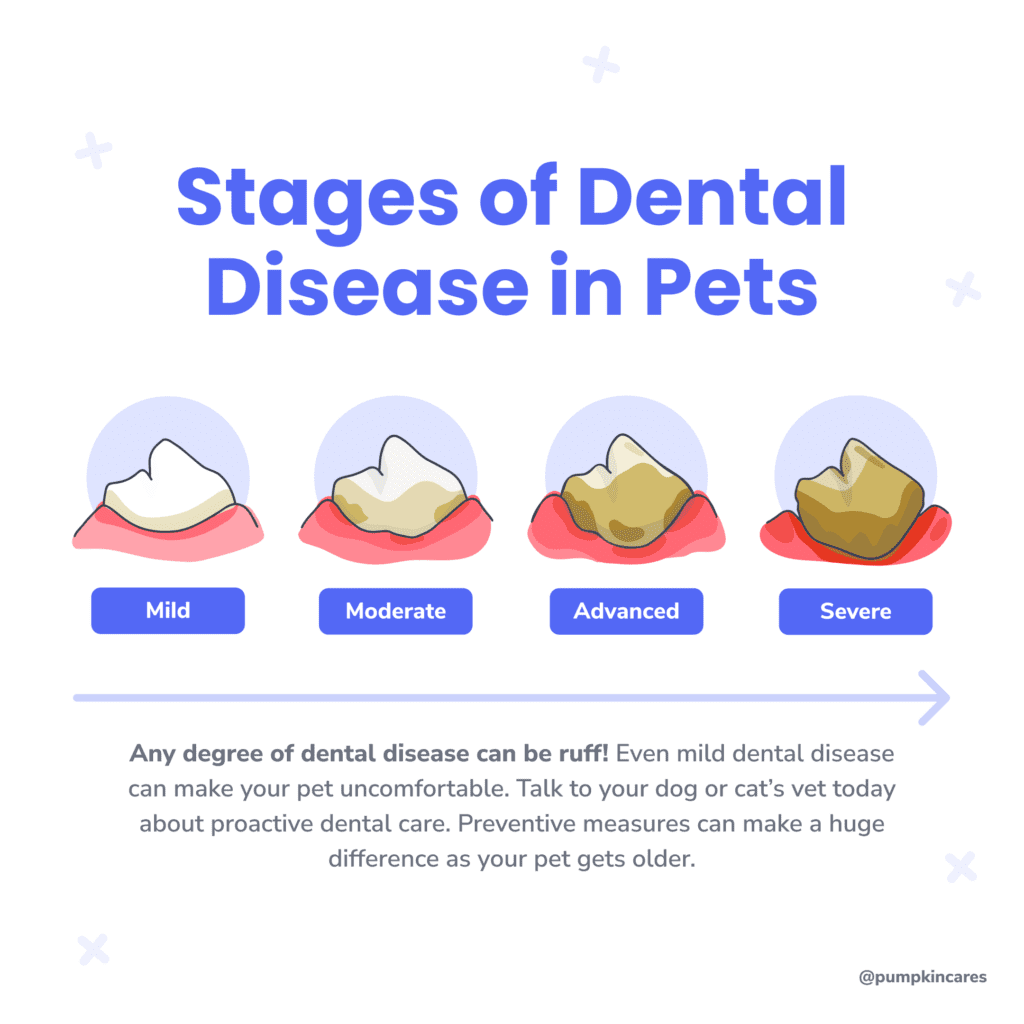Taking care of your dog’s teeth is just as important as taking care of your own. Although dog teeth cleaning may not seem too serious, it can actually have a big impact on your pup’s overall health – especially considering that periodontal disease, or dental disease, is one of the most commonly diagnosed conditions in dogs.
So, if you’re wondering how dog teeth cleaning works, you’ve come to the right place. We’ll cover everything you need to know about promoting good oral hygiene at home.
Key Points
- Regular teeth cleaning helps prevent dental disease, which is extremely common in dogs.
- Some dogs may benefit from a professional cleaning with a veterinarian every 12 to 24 months.
- On top of brushing your dog’s teeth at home, chew toys and dental sprays among other products, can all support oral health.
Why is dog teeth cleaning important?
Many of us don’t realize that dog dental health isn’t that different from our own. We brush our teeth to protect our gums and prevent disease, and cleaning our dog’s teeth can help them do the same!
Just like we get bad breath from neglecting our oral health, dogs do, too. Despite what many people believe, “dog breath” isn’t normal. If your dog has bad breath, it could be a sign that disease is starting to develop.
In fact, according to the American Animal Hospital Association (AAHA), most dogs have some degree of periodontal disease by the time they reach age three. This is one of the reasons it’s so important to start cleaning your dog’s teeth at a young age.
If your dog’s dental disease goes untreated, it can cause chronic pain, inflammation, and even tooth loss. What’s more, some dogs are good at hiding mouth pain, so you might not realize there’s a problem until the pain becomes extremely uncomfortable for them.
This is one of the many reasons why it’s important to take your dog to a veterinarian for regular checkups.
How often does my dog need a teeth cleaning?
While experts recommend brushing your dog’s teeth every day, you should strive to do so at least once a week. Some dogs can benefit from a professional cleaning every 12 to 24 months, depending on your veterinarian’s recommendation and the needs of your pup.
For example, small dogs, like Yorkshire Terriers and Chihuahuas, may need more frequent cleanings as these dogs’ teeth crowd in their smaller mouths making them prone to gingivitis and dental disease. Additionally, if you have a dog who won’t let you anywhere near their mouths, a professional dental cleaning may be the only way to clean those pearly whites.
If your dog starts showing any of these signs, they might need a dental cleaning with your veterinarian:
- Excessively bad breath.
- Broken or loose teeth.
- Bleeding, redness, or swelling of the gums or mouth.
- Discolored or plaque-covered teeth.
- Abnormal chewing, drooling, or dropping food.
- Reduced appetite or refusal to eat.
What happens during a professional dental cleaning?
Most canine dental procedures are performed under general anesthesia. When you bring your dog in for a professional cleaning, your veterinarian will start by running bloodwork to ensure that your pup’s health is safe for sedation.
During the procedure, your veterinarian will perform a thorough dental exam, checking for broken or loose teeth, cavities, and any other oral abnormalities. Your veterinarian may also take x-rays of your dog’s mouth to look for any issues that aren’t visible to the naked eye.
For your dog’s dental cleaning, your veterinarian will use special tools, such as an ultrasonic scaler, to remove plaque and tartar buildup from above and below the gum line. They will also polish your dog’s teeth and in some cases, apply fluoride. Sometimes, tooth extractions are required for diseased teeth, and in these cases, your dog may go home with antibiotics and medication to control pain.
Because dental issues can be difficult to predict in advance of the visit, your veterinarian may contact you during the course of the procedure to discuss additional treatments, such as extractions, if necessary.
How to clean your dog’s teeth at home
One of the best ways to prevent dental disease and support your dog’s oral health is to brush their teeth at home. Here are some tips to get started with dog teeth cleaning:
1. Brush daily
Although it might seem intimidating at first, the more often you brush your dog’s teeth, the better. There are toothbrushes and toothpastes specifically designed for dogs with yummy flavors like beef or chicken. You can try out different options to figure out what suits your pup best.
You might try out flavored dog toothpaste, longer toothbrushes with soft bristles, or finger brushes. Veterinarians recommend that you brush once a day, but if you can’t brush that frequently, try to at least brush once a week. It takes 72 hours for plaque buildup (which is easy to remove) to turn into tartar (hard buildup that can only be removed by a veterinarian).
A health care rule of thumb: Whenever you’re brushing your dog’s coat, make a habit of brushing their teeth as well. And if your dog’s mouth is too small for a brush, you can also wrap a dental wipe around your finger and wipe their teeth.
2. Invest in chew toys
If you want to kill two squeaky birds with one stone, you can let your dog chew on a toy. Chewing is the most natural way to promote dog teeth cleaning, as gnawing scrapes off plaque from their teeth.
Rotating different toys is a good idea; it engages dogs’ natural instincts and keeps things fresh and interesting. Here are chew toys designed specifically for dental health, but there are so many others that you can try out!
3. Try a dog dental spray
While tooth brushing is the best way to promote oral health, dog dental sprays are a quick and easy way to take care of your dog’s teeth when you don’t have time to brush. These sprays kill plaque-causing bacteria and freshen up that breath!Try spraying your pet’s teeth and gums or their favorite toy. Here’s one spray that’s recommended for dogs as well as cats.
4. Feed your dog a healthy diet
The right diet is essential to your dog’s overall well-being – including their dental hygiene. Although it was once thought that eating dry food, or kibble, was better for dog teeth than wet food, veterinarians now know that this isn’t true. Both types of food can lead to the development of plaque, however, there are specific dog foods designed for dental health.
The Veterinary Oral Health Council (VOHC) maintains an ongoing list of foods, water additives, chews, and other products that they recommend for good dental health. VOHC is an entity of the American Veterinary Dental College that recognizes products that help reduce plaque and tartar in dogs and cats.
The bottom line on dog teeth cleaning
Dental health is key to helping your pup live a happy and healthy life. It’s important to talk to your veterinarian about your dog’s oral hygiene and to bring them in for regular checkups. If you ever have concerns about your dog’s teeth, your veterinarian is your best resource.
And don’t forget, developing a regular teeth cleaning routine at home can help prevent dental disease and make professional cleanings that much easier.
In the event that dental disease does strike, it can help to have pet insurance with dental coverage. That’s why Pumpkin Dog Insurance plans help cover eligible treatment for illnesses like gum disease.





